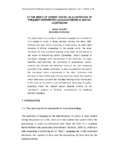| dc.contributor.author | Kiguru, Gatitu | |
| dc.date.accessioned | 2014-12-09T08:53:28Z | |
| dc.date.available | 2014-12-09T08:53:28Z | |
| dc.date.issued | 2010 | |
| dc.identifier.citation | The University of Nairobi Journal of Language and Linguistics, Vol. 1 (2010), 1-18 | en_US |
| dc.identifier.uri | http://hdl.handle.net/11295/76845 | |
| dc.identifier.uri | https://linguistics.uonbi.ac.ke/basic-page/university-nairobi-journal-linguistics-and-languages | |
| dc.description.abstract | n a sample of courts in Kenya between January and March 2008.
Drawing from data mainly consisting of transcriptions of audio-taped
discourse of official proceedings in the sample courts, the paper
illustrates the most prevalent language errors made by interpreters in
the course on interpreting judicial proceedings. Using a typology of
interpreter language errors documented in the literature, the paper
identifies and illustrates the occurrence of grammatical, lexical,
omission and intrusion and distortion errors as the most frequently
occurring in the sample courtrooms, as they accounted for the bulk of
the interpreter errors encountered in the data. Illustration and
discussion of each of this type of errors show that reveal the extent to
which these errors can alter the intended meaning of the interlocutors
in the court set-up, which in turn can lead to a miscarriage of justice,
especially where the judicial process depends entirely on the
interpreter’s capacity to facilitate communication by mediating
between languages. | en_US |
| dc.language.iso | en | en_US |
| dc.publisher | University of Nairobi | en_US |
| dc.subject | University of Nairobi Journal of Linguistics and Languages | |
| dc.title | At the mercy of others’ voices: an illustration of frequent interpreter language errors in kenyan courtrooms | en_US |
| dc.type | Article | en_US |
| dc.type.material | en_US | en_US |


